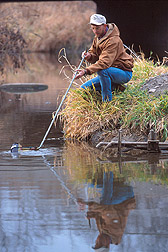This page has been archived and is being provided for reference purposes only. The page is no longer being updated, and therefore, links on the page may be invalid.
Read the magazine story to find out more. | Science Makes Farming More Productive, Environmentally FriendlyBy Kim KaplanNovember 24, 2003 Agriculture and caring for the environment do not have to be at odds. By helping to provide a strong scientific basis for farming decisions, the Agricultural Research Service--now celebrating its 50th anniversary--has made agriculture more environmentally sensitive, while maintaining farming's economic vitality. Since the Agricultural Research Service was created in 1953 as the U.S. Department of Agriculture's chief in-house scientific research agency, it has made many advances that have helped preserve the nation's natural resources. For example, ARS has helped prevent the erosion of billions of tons of topsoil in the United States by developing the Universal Soil Loss Equation and its subsequent revisions. This was the first complex soil model that integrated different farming practices with a multitude of environmental factors to predict the effect on soil erosion. It remains the prototype for all mathematical systems that attempt to model environmental processes. As a federal agency with its own laboratories and scientific staff, ARS is uniquely suited to conduct long-term, large-scale environmental research such as the five Management System Evaluation Areas (MSEA) projects, which ran from 1990-1999 and evaluated the impact of farming practices on nitrate and pesticide contamination of water resources in the Midwest corn belt. Few agriculture and water quality programs have been as ambitious and successful as MSEA, which helped farmers to be more efficient with nitrogen fertilizer and pesticide applications. New irrigation inventions from ARS such as surge valves, water measurement devices, and automated controls are also helping farmers make better use of ever more in-demand water resources. ARS scientists, along with colleagues at other federal agencies and universities, have also done the research that has encouraged many farmers to put away the moldboard plow and switch to conservation tillage to prevent erosion. This system may have shifted soil from a net carbon dioxide producer to a net accumulator of carbon in the form of valuable organic matter. For more information about how ARS research has helped preserve our natural resources, see the November issue of Agricultural Research magazine. |

